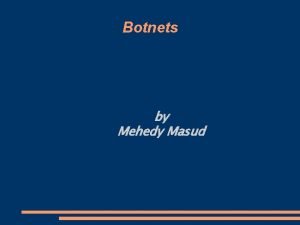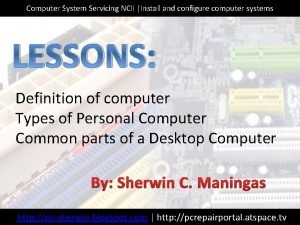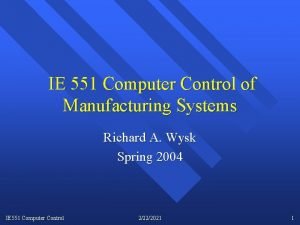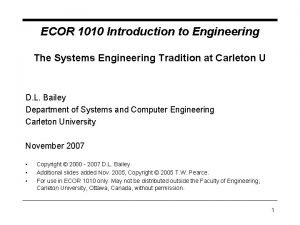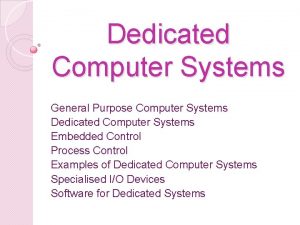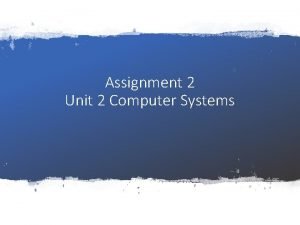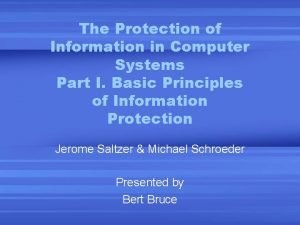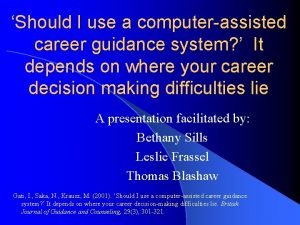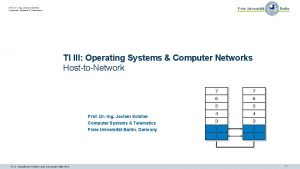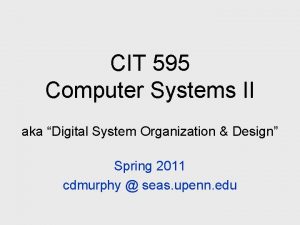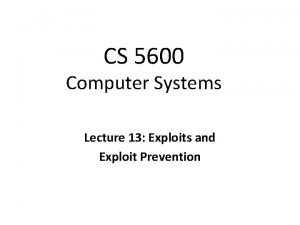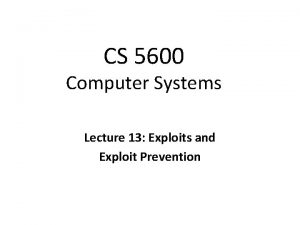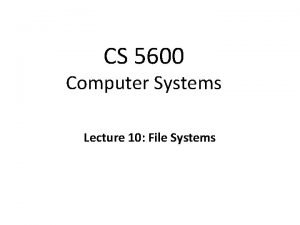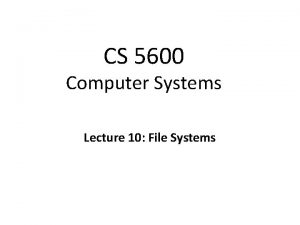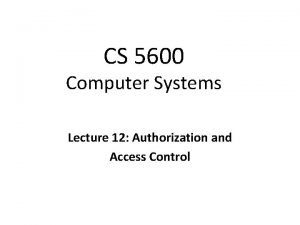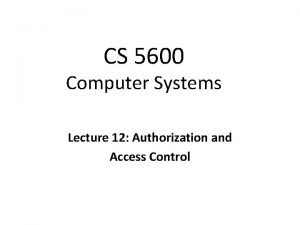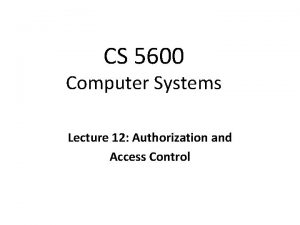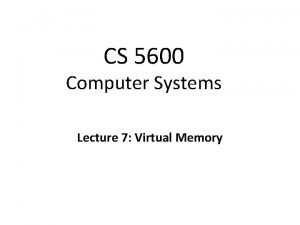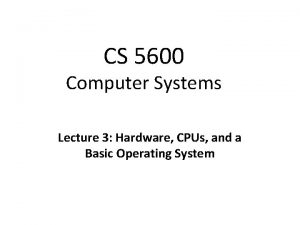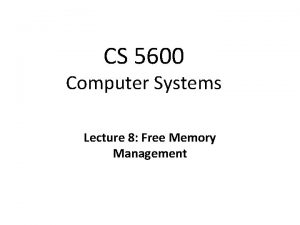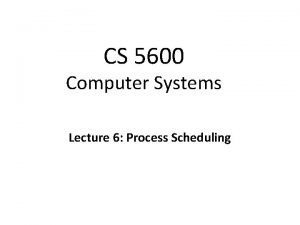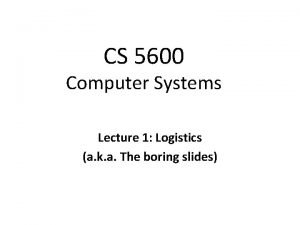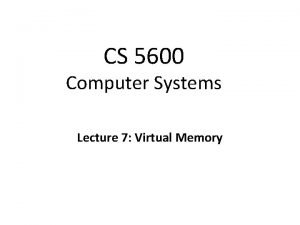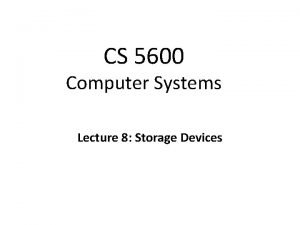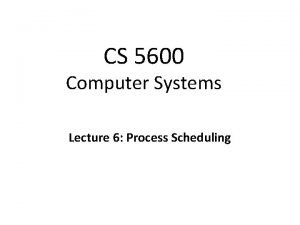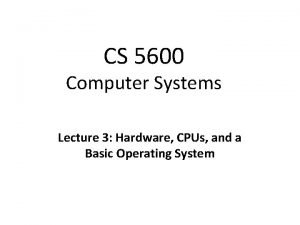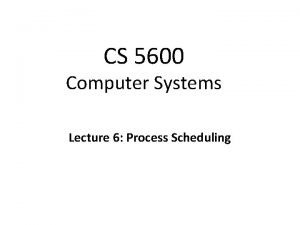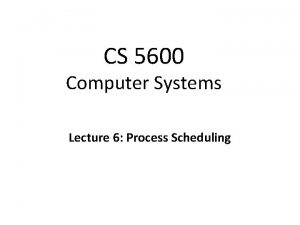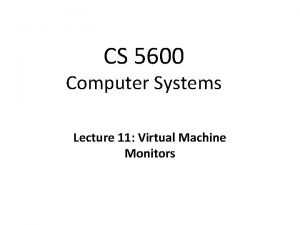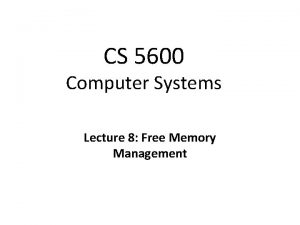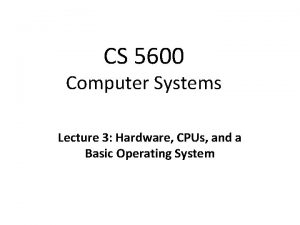CS 5600 Computer Systems Lecture 13 Exploits and


![Setting the Stage Game executable is setuid [cbw@finalfight game] ls -lh -rw------- 1 amislove Setting the Stage Game executable is setuid [cbw@finalfight game] ls -lh -rw------- 1 amislove](https://slidetodoc.com/presentation_image_h2/b234ec8891b85a22023148cf014849cc/image-3.jpg)
![Looking for Vulnerabilities • Code snippet for guessinggame char buf[8]; for (int x = Looking for Vulnerabilities • Code snippet for guessinggame char buf[8]; for (int x =](https://slidetodoc.com/presentation_image_h2/b234ec8891b85a22023148cf014849cc/image-4.jpg)
![Confirmation [cbw@finalfight game] ls -lh -rw------- 1 amislove faculty 180 Jan 23 11: 25 Confirmation [cbw@finalfight game] ls -lh -rw------- 1 amislove faculty 180 Jan 23 11: 25](https://slidetodoc.com/presentation_image_h2/b234ec8891b85a22023148cf014849cc/image-5.jpg)

![Exploitation, Try #1 [cbw@finalfight game]. /guessinggame [16 -bytes of garbage][4 -byte stack pointer][evil shellcode Exploitation, Try #1 [cbw@finalfight game]. /guessinggame [16 -bytes of garbage][4 -byte stack pointer][evil shellcode](https://slidetodoc.com/presentation_image_h2/b234ec8891b85a22023148cf014849cc/image-7.jpg)

![Exploitation, Try #2 . /guessinggame ran the shellcode, turned into /bin/sh [cbw@finalfight game]. /guessinggame Exploitation, Try #2 . /guessinggame ran the shellcode, turned into /bin/sh [cbw@finalfight game]. /guessinggame](https://slidetodoc.com/presentation_image_h2/b234ec8891b85a22023148cf014849cc/image-9.jpg)
![Types of Exploitable Flaws • Stack overflow • Heap overflow • Format string printf(argv[1]); Types of Exploitable Flaws • Stack overflow • Heap overflow • Format string printf(argv[1]);](https://slidetodoc.com/presentation_image_h2/b234ec8891b85a22023148cf014849cc/image-10.jpg)







![Canaries in Action [cbw@finalfight game]. /guessinggame AAAAAAAAAAAA *** stack smashing detected ***: . /guessinggame Canaries in Action [cbw@finalfight game]. /guessinggame AAAAAAAAAAAA *** stack smashing detected ***: . /guessinggame](https://slidetodoc.com/presentation_image_h2/b234ec8891b85a22023148cf014849cc/image-18.jpg)


















- Slides: 36

CS 5600 Computer Systems Lecture 13: Exploits and Exploit Prevention

• Basic Program Exploitation • Protecting the Stack • Advanced Program Exploitation • Defenses Against ROP • Kernel Exploits and Rootkits 2
![Setting the Stage Game executable is setuid cbwfinalfight game ls lh rw 1 amislove Setting the Stage Game executable is setuid [cbw@finalfight game] ls -lh -rw------- 1 amislove](https://slidetodoc.com/presentation_image_h2/b234ec8891b85a22023148cf014849cc/image-3.jpg)
Setting the Stage Game executable is setuid [cbw@finalfight game] ls -lh -rw------- 1 amislove faculty 180 Jan 23 11: 25 secrets. txt -rwsr-sr-x 4 amislove faculty 8. 5 K Jan 23 11: 25 guessinggame • Suppose I really want to see the secret answers – But I’m not willing to play the game • How can I run arbitrary code as amislove? – If I could run code as amislove, I could read secrets. txt – Example: execvp(“/bin/sh”, 0); 3
![Looking for Vulnerabilities Code snippet for guessinggame char buf8 for int x Looking for Vulnerabilities • Code snippet for guessinggame char buf[8]; for (int x =](https://slidetodoc.com/presentation_image_h2/b234ec8891b85a22023148cf014849cc/image-4.jpg)
Looking for Vulnerabilities • Code snippet for guessinggame char buf[8]; for (int x = 1; x < argc; ++x) { strcpy(buf, argv[x]); num = atoi(buf); check_for_secret(num); } Stack buffer overflow 4
![Confirmation cbwfinalfight game ls lh rw 1 amislove faculty 180 Jan 23 11 25 Confirmation [cbw@finalfight game] ls -lh -rw------- 1 amislove faculty 180 Jan 23 11: 25](https://slidetodoc.com/presentation_image_h2/b234ec8891b85a22023148cf014849cc/image-5.jpg)
Confirmation [cbw@finalfight game] ls -lh -rw------- 1 amislove faculty 180 Jan 23 11: 25 secrets. txt -rwsr-sr-x 4 amislove faculty 8. 5 K Jan 23 11: 25 guessinggame [cbw@finalfight game]. /guessinggame 1 2 3 Sorry, none of those number are correct : ( [cbw@finalfight game]. /guessinggame AAAAAAAAAAAA Sorry, none of those number are correct : ( Segmentation fault (core dumped) (gdb) bt #0 0 x 00000400514 #1 0 x 41414141 #2 0 x 41414141 #3 0 x 41414141 #4 0 x 000000414141 in in in ‘A’ = 0 x 41 in ASCII myfunc () ? ? () 5

Exploiting Stack Buffer Overflows Stack • Preconditions for a successful exploit 1. Overflow is able to overwrite the return address 2. Contents of the buffer are under the attackers control Stuff from previousassembly frame Malicious instructions execvp(“/bin/sh”, 0); ESP - 20 ESP - 16 ESP - 12 ESP - 8 Address assembly returnofaddress int num int x Garbage char buf[8] ESP 6
![Exploitation Try 1 cbwfinalfight game guessinggame 16 bytes of garbage4 byte stack pointerevil shellcode Exploitation, Try #1 [cbw@finalfight game]. /guessinggame [16 -bytes of garbage][4 -byte stack pointer][evil shellcode](https://slidetodoc.com/presentation_image_h2/b234ec8891b85a22023148cf014849cc/image-7.jpg)
Exploitation, Try #1 [cbw@finalfight game]. /guessinggame [16 -bytes of garbage][4 -byte stack pointer][evil shellcode assembly] Segmentation fault (core dumped) This is not what we want : ( • Problem: how do you know the address of the shellcode on the stack? – To execute the shellcode, you have to return to its exact start address – This is a small target 7

NOP Sled • To execute the shellcode, you have to return to its exact start address • You can increase the size of the target using a NOP sled (a. k. a. slide, ramp) Stack Stuff from previous frame NOP sled ESP - 20 ESP - 16 ESP - 12 ESP - 8 Malicious assembly instructions Full of 0 x 90 (NOP x 86 instructions) execvp(“/bin/sh”, 0); Address assembly returnofaddress int num int x Garbage char buf[8] ESP 8
![Exploitation Try 2 guessinggame ran the shellcode turned into binsh cbwfinalfight game guessinggame Exploitation, Try #2 . /guessinggame ran the shellcode, turned into /bin/sh [cbw@finalfight game]. /guessinggame](https://slidetodoc.com/presentation_image_h2/b234ec8891b85a22023148cf014849cc/image-9.jpg)
Exploitation, Try #2 . /guessinggame ran the shellcode, turned into /bin/sh [cbw@finalfight game]. /guessinggame [16 bytes of garbage][4 byte stack pointer][2048 bytes of 0 x 90][evil shellcode assembly] $ • There is a lot more to writing a successful exploits – Depending on the type of flaw, compiler countermeasures, and OS countermeasures – If you like this stuff, take a security course 9
![Types of Exploitable Flaws Stack overflow Heap overflow Format string printfargv1 Types of Exploitable Flaws • Stack overflow • Heap overflow • Format string printf(argv[1]);](https://slidetodoc.com/presentation_image_h2/b234ec8891b85a22023148cf014849cc/image-10.jpg)
Types of Exploitable Flaws • Stack overflow • Heap overflow • Format string printf(argv[1]); • Off-by-one char * buf = malloc(100); strcpy(buf, argv[1]); • Double free(buf); int vectors[100]; for (i = 0; i <= 100; i++) vector[i] = x; • … and many more 10

Triggering Exploitable Flaws • Local vulnerabilities: Attacker can inject code – Command line arguments into your machine via the – Environment variables Internet – Data read from a file – Date from shared memory or pipes • Remote vulnerabilities – Data read from a socket • Basically, any place where an attacker can give input to your process 11

Leveraging an Exploit • After a successful exploit, what can the attacker do? – Anything the exploited process could do – The shellcode has full API access • Typical shellcode payload is to open a shell – Remote exploit: open a shell and bind STDIN/STDOUT to a socket (remote shell) • If process is uid=root or setuid=root, exploitation results in privilege escalation • If the process is the kernel, the exploit also results in privilege escalation 12

• Basic Program Exploitation • Protecting the Stack • Advanced Program Exploitation • Defenses Against ROP • Kernel Exploits and Rootkits 13

Defending Against Stack Exploits • Exploits leverage programmer bugs – Programmers are never going to write code that is 100% bug-free • What can the system do to help prevent processes from being exploited? • Mechanisms that prevent stack-based exploits – Stack canaries – Non-executable stack pages (NX-bit) 14

The Canary in the Coal Mine • Miners used to take canaries down into mines • The birds are very sensitive to poisonous gases • If the bird dies, it means something is very wrong! • The bird is an early warning system 15

Stack Canaries • A stack canary is an early warning system that alerts you to stack overflows Automatically added by the compiler int canary = secret_canary; char buf[8]; for (x = 1; x < argc; ++x) { strcpy(buf, argv[x]); num = atoi(buf); check_for_secret(num); }. . . assert(canary==secret_canary); return 0; Stack Malicious shellcode Overflow destroys the Stuff from previous frame canary, assert fails, program safely exits NOP sled ESP - 24 ESP - 20 ESP - 16 ESP - 12 ESP - 8 return address Pointer sled canary to value int num int x Garbage char buf[8] ESP 16

Canary Implementation • Canary code and data are inserted by the compiler – gcc supports canaries – Disable using the –fno-stack-protector argument • Canary secret must be random – Otherwise the attacker could guess it • Canary secret is stored on its own page at semirandom location in virtual memory – Makes it difficult to locate and read from memory 17
![Canaries in Action cbwfinalfight game guessinggame AAAAAAAAAAAA stack smashing detected guessinggame Canaries in Action [cbw@finalfight game]. /guessinggame AAAAAAAAAAAA *** stack smashing detected ***: . /guessinggame](https://slidetodoc.com/presentation_image_h2/b234ec8891b85a22023148cf014849cc/image-18.jpg)
Canaries in Action [cbw@finalfight game]. /guessinggame AAAAAAAAAAAA *** stack smashing detected ***: . /guessinggame terminated Segmentation fault (core dumped) • Note: canaries do not prevent the buffer overflow • The canary prevents the overflow from being exploited 18

When Canaries Fail void my_func() {. . . } Function pointer Canary is left intact ESP - 1036 ESP - 1032 ESP - 1028 ESP - 1024 Stack return address canary value Pointer to sled fptr Malicious shellcode int canary = secret_canary; void (*fptr)(void); char buf[1024]; fptr = &my_func; Calling fptr triggers strcpy(buf, argv[1]); the exploit fptr(); assert(canary==secret_canary); return 0; char buf[1024] NOP sled ESP 19

Pro. Police Compiler • Security oriented compiler technique • Attempts to place arrays above other local variables on the stack • Integrated into gcc ESP - 1036 ESP - 1032 ESP - 1028 Stack return address canary value char buf[1024] ESP - 4 ESP fptr 20

When Pro. Police Fails void my_func() {. . . } struct my_stuff { void (*fptr)(void); char buf[1024]; }; • The C specification states that the fields of a struct cannot be reordered by the compiler int canary = secret_canary; struct my_stuff; stuff. fptr = &my_func; strcpy(stuff. buf, argv[1]); stuff. fptr(); assert(canary==secret_canary); return 0; 21

Non-Executable Stack • Problem: compiler techniques cannot prevent all stack-based exploits • Key insight: many exploits require placing code in the stack and executing it – Code doesn’t typically go on stack pages • Solution: make stack pages non-executable – Compiler marks stack segment as non-executable – Loader sets the corresponding page as nonexecutable 22

x 86 Page Table Entry, Again • On x 86, page table entries (PTE) are 4 bytes 31 - 12 11 - 9 8 Page Frame Number (PFN) Unused G 7 6 5 4 3 2 1 0 PAT D A PCD PWT U/S W P • W bit determines writeable status • … but there is no bit for executable/nonexecutable • On x 86 -64, the most significant bit of each PTE (bit 63) determines if a page is executable – AMD calls it the NX bit: No-e. Xecute – Intel calls it the XD bit: e. Xecute Disable 23

When NX bits Fail • NX prevents shellcode from being placed on the stack – NX must be enabled by the process – NX must be supported by the OS • Can exploit writers get around NX? – Of course ; ) – Return-to-libc – Return-oriented programming (ROP) 24

• Basic Program Exploitation • Protecting the Stack • Advanced Program Exploitation • Defenses Against ROP • Kernel Exploits and Rootkits 25

Return to libc Parameters for a call to execvp() “/bin/sh” char ** argv char * file • Example exploits thus far have leveraged code injection • Why not use code that is already available in the process? execvp(char * file, char ** argv); 0 Ptr to string Fake return addr 0 x 007 F 0 A 82 return address Current stack frame ESP libc Library 0 x 007 F 0 A 82 IP E 0 x 007 F 0000 execvp()

Stack Control = Program Control • Return to libc works by crafting special stack frames and using existing library code – No need to inject code, just data onto the stack • Return-oriented programming (ROP) is a generalization of return to libc – Why only jump to existing functions? – You can jump to code anywhere in the program – Gadgets are snippets of assembly that form a Turing complete language – Gadgets + control of the stack = arbitrary code execution power 27

• Basic Program Exploitation • Protecting the Stack • Advanced Program Exploitation • Defenses Against ROP • Kernel Exploits and Rootkits 28

Defending Against Return to libc • Return to libc and ROP work by repeatedly returning to known pieces of code 264 -1 Stack Region Stack – This assumes the attacker knows the addresses of this code in memory Heap Region Heap • Key idea: place code and data at random places in memory – Address Space Layout Randomization (ASLR) – Supported by all modern OSes Virtual Memory Code Region Code 0

Randomizing Code Placement • It’s okay for stack and heap to be placed randomly 264 -1 Virtual Memory – Example: stack is accessed relative to ESP • Problem: code is typically compiled assuming a fixed load address Process 2 Addr of foo(): 0 x 0 DEB 49 A 3 Addr of foo(): 0 x 000 FE 4 D 8 Process 1 0

Position Independent Code Example • Modern compilers produce Position • e 8 is thecan opcode for a relative function call • Address is calculated as EIP + given value Independent Code (PIC) Example: 0 x 4004 cc + 0 xffffffe 8 = 0 x 4004 b 4 – Also called • Position Independent Executable (PIE) int global_var = 20; int func() { return 30; } int main() { int x = func(); global_var = 10; return 0; } 004004 b 4 <func>: Global data is accessed relative to EIP 004004 bf <main>: 4004 bf: 55 4004 c 0: 48 89 e 5 4004 c 3: 48 83 ec 10 4004 c 7: e 8 ff ff ff 4004 cc: 89 45 fc 4004 cf: c 7 05 3 f 0 b 20 00 10 4004 d 6: 4004 d 9: 4004 de: 4004 df: 00 00 00 b 8 00 00 c 9 c 3 push ebp mov ebp, esp sub esp, 0 x 10 call 4004 b 4 <func> mov [ebp-0 x 4], eax mov [eip+0 x 200 b 3 f], 0 x 10 mov eax, 0 x 0 leave ret 31

Tradeoffs with PIC/PIE • Pro – Enables the OS to place the code and data segments at a random place in memory (ASLR) • Con – Code is slightly less efficient – Some addresses must be calculated • In general, the security benefits of ASLR far outweigh the cost 32

When ASLR Fails • ASLR is much less effective on 32 -bit architectures – Less ability to move pages around randomly – May allow the attacker to brute-force the exploit • Use a huge NOP sled – If the sled is enormous, even a random jump will hit it • Use heap spraying – Technique that creates many, many copies of shellcode in memory – Attempts to fill available heap memory – Jump to a random address is likely to hit a copy 33

Exploitation Prevention Wrap-up • Modern OSes and compilers implement many strategies to prevent exploitation – More advanced techniques exist and are under development • Exploitation strategies are also becoming more sophisticated – Just scratched the surface of attack strategies • Bottom line: don’t write buggy code – Compiler and OS techniques don’t fix bugs, they just try to prevent exploitation – Even minor flaws can be exploited 34

Strategies for Writing Secure Code • Assume all external data is under the control of an attacker • Avoid unsafe library calls – strcpy(), memcpy(), gets(), etc. – Use bounded versions instead, i. e. strncpy() • Use static analysis tools, e. g. Valgrind • Use a fuzzer – Runs your program repeatedly with crafted inputs – Designed to trigger flaws • Use security best-practices – Drop privileges, use chroot jails, etc. 35

• Basic Program Exploitation • Protecting the Stack • Advanced Program Exploitation • Defenses Against ROP • Kernel Exploits and Rootkits 36
 Einstein frases celebres
Einstein frases celebres 5600 in scientific notation
5600 in scientific notation Tcp exploits
Tcp exploits Great exploits kjv
Great exploits kjv Agobot source code
Agobot source code Pillars of eternity exploits
Pillars of eternity exploits 01:640:244 lecture notes - lecture 15: plat, idah, farad
01:640:244 lecture notes - lecture 15: plat, idah, farad Operating system lecture notes
Operating system lecture notes Lecture sound systems
Lecture sound systems Lecture sound systems
Lecture sound systems Computer security 161 cryptocurrency lecture
Computer security 161 cryptocurrency lecture Computer aided drug design lecture notes
Computer aided drug design lecture notes Computer architecture notes
Computer architecture notes Computer architecture lecture
Computer architecture lecture Decision support systems and intelligent systems
Decision support systems and intelligent systems Installing and configure computer systems
Installing and configure computer systems Integration using tables and computer algebra systems
Integration using tables and computer algebra systems Objective of computer system
Objective of computer system What is computer organization
What is computer organization Keyboard mouse scanner and microphone are blank devices
Keyboard mouse scanner and microphone are blank devices Computer architecture and organisation
Computer architecture and organisation Dicapine
Dicapine Embedded systems vs cyber physical systems
Embedded systems vs cyber physical systems Elegant systems
Elegant systems Computer control of manufacturing systems
Computer control of manufacturing systems Ecor 1010
Ecor 1010 General purpose computer system
General purpose computer system Computer networks vs distributed systems
Computer networks vs distributed systems Direct motion specification in computer graphics
Direct motion specification in computer graphics Computer systems unit
Computer systems unit Unit 2 task 2
Unit 2 task 2 The protection of information in computer systems
The protection of information in computer systems Conclusion of computerised accounting
Conclusion of computerised accounting Computer assisted guidance systems
Computer assisted guidance systems Computer systems
Computer systems Cs 1104
Cs 1104 Cit computer systems
Cit computer systems




